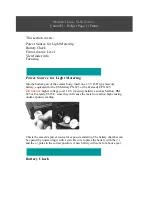
Cheetah Python Cameras User Manual | CoaXPress (CXP) Interface
August 27, 2019
Page
26
of
86
Rev 1.0
Configuring the Camera
Overview
Cheetah cameras are programmable and flexible. You can monitor and control all of the
camera’s resources, camera settings, internal registers, video amplifiers, parameter flash,
and so on. You communicate with the camera from a simple GenICam compliant graphical
user interface (GUI). The GUI is bi-directional allowing you to issue commands to the
camera and enabling the camera to issue responses (either status or information).
The CXP camera contains an XML parameters file enabling you to configure your camera’s
features and functions. The frame grabber you use to view the camera’s images should also
provide a GenICam compliant programming interface for configuring the camera.
Camera Configuration Memory
Parameter Flash
The camera has a built-in configuration memory divided into four segments: Work Space,
Factory Space, User Space #1, and User Space #2. The Work Space segment contains the
current camera settings while the camera is powered up and operational. All camera
registers are located in this space. You can program these registers and issue commands to
retrieve data.
The Work Space is RAM based. All camera registers clear upon camera power-down. The
Factory Space segment is ROM based, write protected, and contains the default camera
settings. This space is available for read operations only. User Space #1 and User Space #2
are non-volatile, flash-based, and used to store two user-defined configurations or User
Sets. Upon power up or software reset, the camera firmware loads the Work Space registers
from the Factory Space, User Space #1, or User Space #2 as determined by a User Set
Default Selector setting.
At any time, you can instruct the camera to load its Work Space with the contents of the
Factory Space, User Space #1, or User Space #2 using the User Set Load command. Similarly,
you can instruct the camera to save the current Work Space settings into either User Space
#1 or User Space #2 using the User Set Save command.
The non-volatile parameter Flash memory also contains the Dead Pixel Map, Hot Pixel Map,
LUT 1, and LUT 2, which can be loaded to the camera internal memory upon enabling the
corresponding camera feature. You can create your own DPM, HPM, and LUT tables and
upload them to the parameter Flash using the Imperx Upload Utility, which is a separate
utility available from the Imperx website
















































